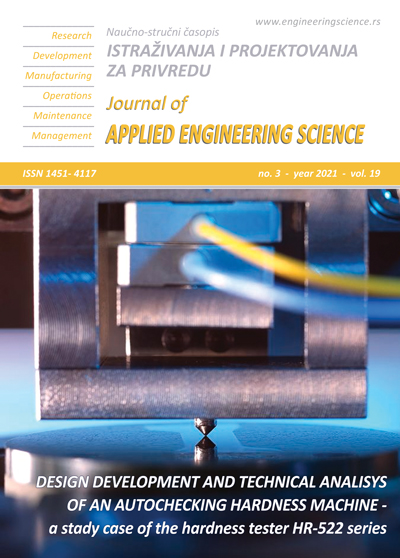OPTIMIZING THE VELOCITY OF RING SHAPE PARAMETER FOR DESIGNING THE NOZZLES USING CFD
Abstract
This study aims to optimize the velocity of ring shape parameter for designing the nozzles using computational fluid dynamics (CFD) and investigated the flow in nozzles using ANSYS, Inc. simulation software. The model geometries were defined using ANSYS FLUENT-Design Modeler platform. All nozzles were designed on unstructured triangular elements comprising of 1200000 mesh nodes. The differential governing equations were applied in ANSYS FLUENT based on a finite volume method. The distance and dimensions of ring location significantly influence the velocity of water during flow where the maximum velocity at double rings reduces the surface area at distance of 7mm and 15mm and 2x2 mm dimensions. Considering 8, 10, and 12 bar liner proportions, there was an increase in the velocity at maximum points in ring shapes.
References
Back, L.H., Massier, P.F., Gier, H.L. (1964). Convective heat transfer in a convergent-divergent nozzle. International Journal of Heat and Mass Transfer, vol. 7, no. 5, 549-568. Doi: https://doi.org/10.1016/0017-9310(64)90052-3
Brusiani, F., Falfari, S., Pelloni, P. (2014). Influence of the Diesel injector hole geometry on the flow conditions emerging from the nozzle. Energy Procedia, vol. 45, 749-758. Doi: https://doi.org/10.1016/j.egypro.2014.01.080
Tamaki, H., Unno, M., Iwakami, A. Ishii, S., (2007). Study on flow fields in variable area nozzles for radial turbines. IHI Engineering review, vol. 40, no. 2, 89-97.nc. Doi: https://doi.org/10.5293/ijfms.2008.1.1.047
Babu, P.C. Mahesh, K. (2004). Upstream entrainment in numerical simulations of spatially evolving round jets. Physics of Fluids, vol. 16, no. 10, 3699-3705. Doi: https://doi.org/10.1063/1.1780548
Matsuo, S., Kim, T.H., Setoguchi, T., Kim, H.D. Lee, Y.W. (2007). Effect of nozzle geometry on the flow characteristics of spiral flow generated through an annular slit. Journal of Thermal Science, vol. 16, no. 2, 149-154. Doi: https://doi.org/10.1007/s11630-007-0149-4
Theerayut, K.S.M.W.H. Nuntadusit, L.C. (2012). Effect of nozzle geometry on flow characteristic of jet from expansion pipe nozzle.
Alam, M.M.A., Setoguchi, T., Matsuo, S., Kim, H.D. (2016). Nozzle geometry variations on the discharge coefficient. Propulsion and Power Research, vol. 5, no. 1, 22-33. Doi: https://doi.org/10.1016/j.jppr.2016.01.002
Belega, B.A. Nguyen, T.D. (2015). Analysis of flow in convergent-divergent rocket engine nozzle using computational fluid dynamics. In Proceedings of International Conference of Scientific Paper AFASES. Brasov, Romania.
Rao, G.R., Ramakanth, U.S. Lakshman, A. (2013). Flow analysis in a convergent-divergent nozzle using CFD. International Journal of Research in Mechanical Engineering, vol. 1, no. 2, 136-144.
Satyanarayana, G., Varun, C. Naidu, S.S., (2013). CFD analysis of convergent-divergent nozzle. Acta Technical Corviniensis-Bulletin of Engineering, vol. 6, no. 3, 139.
Mohamed, S., Mokhtar, A. Chatti, T.B. (2017). Numerical simulation of the compressible flow in convergent-divergent nozzle. International Journal of Heat and Technology, vol. 35, no. 1, 673-677. Doi: https://doi.org/10.18280/ijht.350328
Payri, R., García, J.M., Salvador, F.J. Gimeno, J., (2005). Using spray momentum flux measurements to understand the influence of diesel nozzle geometry on spray characteristics. Fuel, vol. 84, no. 5, 551-561. Doi: https://doi.org/10.1016/j.fuel.2004.10.009
Macián, V., Payri, R., Margot, X. Salvador, F.J. (2003). A CFD analysis of the influence of diesel nozzle geometry on the inception of cavitation. Atomization and sprays, vol. 13, no. 5&6. Doi: https://doi.org/10.1615/atomizspr.v13.i56.80
Du, H., Liu, J. Tang, J. (2008). A CFD Investigation on the Nozzle of Orifices Distributing in Different Space Layers (No. 2008-01-0948). SAE Technical Paper. Doi: https://doi.org/10.4271/2008-01-0948
Masuda, R., Fuyuto, T., Nagaoka, M., von Berg, E. Tatschl, R. (2005). Validation of diesel fuel spray and mixture formation from nozzle internal flow calculation (No. 2005-01-2098). SAE Technical Paper. Doi: https://doi.org/10.4271/2005-01-2098
Giannadakis, E., Gavaises, M. Arcoumanis, C. (2008). Modelling of cavitation in diesel injector nozzles. Journal of Fluid Mechanics, vol. 616, 153-193. Doi: https://doi.org/10.1017/s0022112008003777
Shan, Y., Zhang, J.Z. Huang, G.P. (2011). Experimental and numerical studies on lobed ejector exhaust system for micro turbojet engine. Engineering Applications of Computational Fluid Mechanics, vol. 5, no. 1, 141-148. Doi: https://doi.org/10.1080/19942060.2011.11015358
Boersma, B.J., Brethouwer, G. Nieuwstadt, F.T. (1998). A numerical investigation on the effect of the inflow conditions on the self-similar region of a round jet. Physics of fluids, vol. 10, no. 4, 899-909. Doi: https://doi.org/10.1063/1.869626
Hussein, H.J., Capp, S.P. George, W.K. (1994). Velocity measurements in a high-Reynolds-number, momentum-conserving, axisymmetric, turbulent jet. Journal of Fluid Mechanics, vol. 258, 31-75. Doi: https://doi.org/10.1017/s002211209400323x
Panchapakesan, N.R. Lumley, J.L. (1993). Turbulence measurements in axisymmetric jets of air and helium. Part 1. Air jet. Journal of Fluid Mechanics, vol. 246, 197-223. Doi: https://doi.org/10.1017/s0022112093000096
Najar, N.A., Dandotiya, D. Najar, F.A. (2013). Comparative analysis of k-ε and spalart-allmaras turbulence models for compressible flow through a convergent-divergent nozzle. The International Journal of Engineering and Science (IJES), vol. 2, no. 8.
Brennan, M.S., Narasimha, M., Holtham, P.N. (2007). Multiphase modelling of hydrocyclones–prediction of cut-size. Minerals Engineering, vol. 20, no. 4, pp.395-406. Doi: https://doi.org/10.1016/j.mineng.2006.10.010
Crowe, C.T., Schwarzkopf, J.D., Sommerfeld, M., Tsuji, Y. (2011). Multiphase flows with droplets and particles. CRC press.
Lim, E.W.C., Chen, Y.R., Wang, C.H., Wu, R.M. (2010). Experimental and computational studies of multiphase hydrodynamics in a hydrocyclone separator system. Chemical Engineering Science, vol. 65, no. 24, 6415-6424. Doi: https://doi.org/10.1016/j.ces.2010.09.029
Zhang, S.B. Zhu, J.M. (2013). Numerical simulation of adjustable nozzles. In IOP Conference Series: Materials Science and Engineering. vol. 52, no. 7, 072014. IOP Publish. Doi: https://doi.org/10.1088/1757-899x/52/7/072014
Yu, Y., Shademan, M., Barron, R.M., Balachandar, R. (2012). CFD study of effects of geometry variations on flow in a nozzle. Engineering applications of computational fluid mechanics, vol, 6, no. 3, pp. 412-425. Doi: https://doi.org/10.1080/19942060.2012.11015432
Bilir, A.Ç., Doğrul, A., Coşgun, T., Yurtseven, A., Vardar, N. (2016). A numerical Investigation of the Flow in Water Jet Nozules. Journal of Thermal Engineering, vol. 2, no. 5, 907-912. Doi: https://doi.org/10.18186/jte.55087

